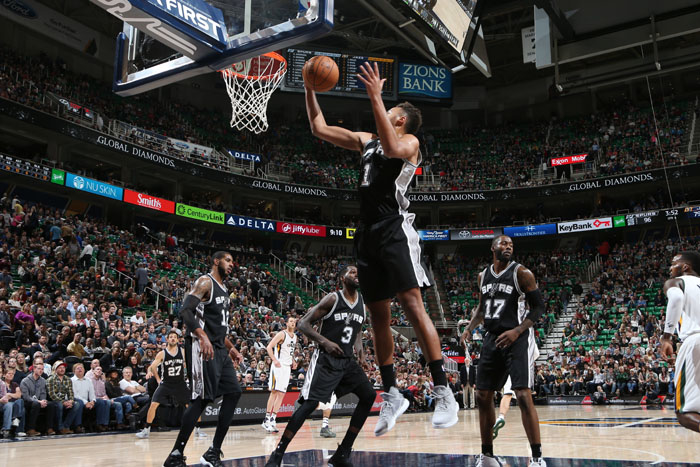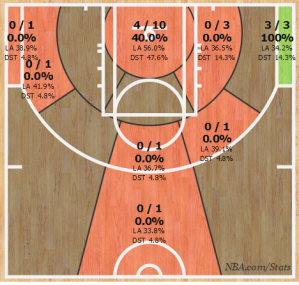It’s been nearly three weeks since Kyle Anderson was named the starting shooting guard for the San Antonio Spurs as they took on the Golden State Warriors.
Per Basketball Reference, it was a position that Anderson played an estimated one percent during the 2015-16 season. But with so many limited options to start the current season, Spurs Head Coach Gregg Popovich went with the versatile forward who has enough corporate knowledge to keep the Spurs’ offense churning, without sacrificing the integrity of his bench.
Anderson’s starting stint ended with three points, four rebounds and a steal in 22 minutes. A subdued night that Anderson has perfected off the bench, letting rebounding and defense be his calling card, while making sure he doesn’t impede the flow of the offense.
Little did we know that would arguably be Anderson’s best game of the season.
The 6-foot-9 Anderson lacks the athleticism and offense to play the wing in the NBA. Even though he’s been a point guard for the majority of his basketball career, his game is more suited to be a “point forward” as the NBA game transitions into almost a position-less era.
Once Boris Diaw was traded to Utah to create the cap space necessary to sign Pau Gasol, it was immediately assumed that Anderson would transition into Diaw’s role. Both players lack the athleticism to play point guard, while having the skill set of a guard who excels with the ball in his hand.
Anderson started in six games for the Spurs as their interim shooting guard, before Danny Green’s return on Wednesday night. But even with consistent minutes, Anderson has underwhelmed significantly, averaging just 3.8 points, 5.0 rebounds and 1.3 assists. Take away his statistics from October, Anderson is averaging just one point and three rebounds, while shooting 13 percent in his last four games. Numbers that are pedestrian compared to his summer league and preseason performance.
The goal to entrust Anderson with more minutes and a bigger role on offense hasn’t come to fruition for a few reasons. As a starter, Anderson’s primary responsibility is to spread the floor. Not an easy thing to do for a guy who’s a career 34 percent 3-point shooter.
[protected-iframe id=”a176b53a73ae1df00e85c543e7fae2d4-114320562-81586714″ info=”https://streamable.com/e/fm1q” width=”600″ height=”338″ frameborder=”0″ scrolling=”no” webkitallowfullscreen=”” mozallowfullscreen=”” allowfullscreen=””]When you watch the play above, notice how far Dion Waiters plays off of Anderson. Using Waiters as an example of anything defensive seems counter-intuitive, but the strategy is sound. Even once Anderson cuts, he’s no threat to the defense with three Miami players clogging the restricted area in an effort to stop Kawhi Leonard.
In fact, Anderson hasn’t been a threat to the defense from anywhere on the floor this season.
Even when Anderson finds himself alone in the corner, defenses have treated him as a spectator. In this sequence, Rodney McGruder and Luke Babbitt hug the lane line to prevent David Lee from gaining position, while Gasol gets a wide open jumper after Hassan Whiteside overplays Tony Parker’s penetration.
Where is Kyle Anderson? Standing in the corner unbothered with enough time to complete his taxes.
[protected-iframe id=”937a61241d3d37b440afc3bedc907125-114320562-81586714″ info=”https://streamable.com/e/7tn3″ width=”600″ height=”338″ frameborder=”0″ scrolling=”no” webkitallowfullscreen=”” mozallowfullscreen=”” allowfullscreen=””]These things aren’t just happening against poor defenders or on possessions when a team would rather focus on Leonard or Gasol instead of Anderson.
Against the Utah Jazz, Anderson rotates from the corner to the top of the key with enough time on the shot clock to reset the offense if the play breaks down. Joe Johnson cheats further into the paint defensively to make Lee think twice about calling his own number, but Lee recognizes quickly that Jeff Withey is out of position and punishes him by clearing enough room with his shoulder for a baby hook.
Where is Anderson? Making s’mores by the campfire at center court.
[protected-iframe id=”80afc5cfbccbbbd7af86f2d2c7c2c1fe-114320562-81586714″ info=”https://streamable.com/e/bb8a” width=”600″ height=”338″ frameborder=”0″ scrolling=”no” webkitallowfullscreen=”” mozallowfullscreen=”” allowfullscreen=””]So what’s wrong with Anderson? How do the Spurs get their 2014 first round draft pick going, when his biggest contribution to the offense right now is spectating from beyond the arc?
It’s simple – put the ball in his damn hands.
Anderson isn’t a ball-dominant player, but with his handling and passing ability, the first step towards getting his offense going is by literally giving him the ball.
Manu Ginobili may be the primary ball handler for the bench unit, but the addition of David Lee has forced Anderson to play almost entirely off the ball as a tweener. Lee doesn’t stretch the floor like Diaw, so using Lee to initiate the offense from the top of the key, something Anderson would prosper at, doesn’t work. Lee and Dewayne Dedmon make their living on the block, pushing Anderson to play a modern day Bruce Bowen on offense, without any of the opportunities.
During summer league and preseason, Anderson’s usage rate hovered around the 16 percent mark. The level of competition doesn’t compare to a regular season NBA game, but Anderson’s ability to score a handful of baskets and crash the boards regularly is something the Spurs need to improve upon, particularly when Patty Mills and Manu Ginobili have an off night.
Currently, Anderson has seen his usage rate cut in half from his career average, as the forward has the lowest usage rate on the team. At 7.5 percent, Anderson uses less of the team’s offensive possessions when he’s on the floor than rookie guard Bryn Forbes. If the solution is as simple as feeding Anderson the ball more consistently, then preliminary results show Anderson is more than capable of handling a larger role.
When the Spurs’ “good to great” mantra is in full effect, Anderson gets 25 percent of his attempts this season without a defender within six feet of him, connecting on 40 percent of those field goals. Even with such a low usage rate, Anderson is producing a high rate of assists despite technically only averaging one per game. His assist ratio of 23.6 per 100 possessions is good enough for fourth on the team, behind the de facto point guards, Tony Parker (33.2), Patty Mills (28.3) and Nicolas Laprovittola (27.8). Not to mention Anderson also has the fourth best Assist to Turnover ratio at 2.0, behind Mills, Parker and Lee.
What does it all mean? Frankly, San Antonio’s rotation is out of whack. With injuries, lack of practice time and a plethora of new faces, it’s been rough trying to find out who plugs in what holes. Right now, Anderson is trying to plug holes at three different positions, with a majority of his time being spent at the guard. He’s played more minutes at shooting guard this season than he has in the previous two years combined. A rough adjustment for anyone, including a player so immersed in Pop’s system.
So the next time you see Kyle Anderson camped out in the corner, don’t sleep on him as opposing defenses are continuing to do. It’s only a matter of time before he hits everyone with one of these:
[protected-iframe id=”ea56d55b1ba13b90b1526d12d69bff03-114320562-81586714″ info=”https://streamable.com/e/794f” width=”600″ height=”338″ frameborder=”0″ scrolling=”no” webkitallowfullscreen=”” mozallowfullscreen=”” allowfullscreen=””]
Add The Sports Daily to your Google News Feed!

